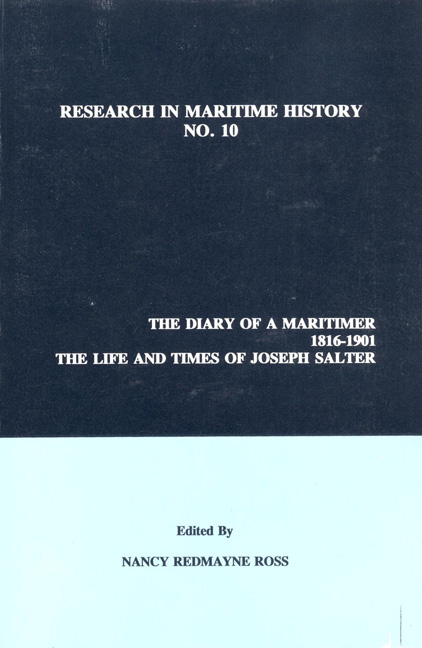Book contents
- Frontmatter
- Contents
- Foreword
- Introduction
- List of Illustrations
- Chapter 1
- Chapter 2
- Chapter 3
- Chapter 4
- Chapter 5
- Chapter 6
- Chapter 7
- Chapter 8
- Chapter 9
- Chapter 10
- Chapter 11
- Chapter 12
- Chapter 13
- Chapter 14
- Chapter 15
- Chapter 16
- Appendix 1 Vessels Owned by G. & J. Salter, 1852-1857
- Appendix 2 Patent Application, 1867
- Appendix 3 Genealogy
- Appendix 4 A Brief History of the Shipyard of G. & J. Salter
Foreword
- Frontmatter
- Contents
- Foreword
- Introduction
- List of Illustrations
- Chapter 1
- Chapter 2
- Chapter 3
- Chapter 4
- Chapter 5
- Chapter 6
- Chapter 7
- Chapter 8
- Chapter 9
- Chapter 10
- Chapter 11
- Chapter 12
- Chapter 13
- Chapter 14
- Chapter 15
- Chapter 16
- Appendix 1 Vessels Owned by G. & J. Salter, 1852-1857
- Appendix 2 Patent Application, 1867
- Appendix 3 Genealogy
- Appendix 4 A Brief History of the Shipyard of G. & J. Salter
Summary
Driving around the coast of New Brunswick, Nova Scotia and Prince Edward Island today, it is difficult to imagine that the region was home to a major shipbuilding industry. Little evidence remains of the hundreds of shipbuilding sites: many of the rivers and inlets where these vessels were built have silted up and are little more than muddy creeks, while other sites have been completely covered by modern development. Yet during the great shipbuilding era, from the late eighteenth to well into the twentieth century, nearly 30,000 wooden sailing vessels were constructed in the Maritime provinces.
For the early settlers, shipping was essential to their survival and critical to colonial development. Not only was shipping their only contact with the outside world but it also was their sole method of communication with communities elsewhere in the region. Even after the coming of the railways in the mid-nineteenth century, small coastal schooners continued to be built and used for many years.
The region's vast forests enabled shipbuilding to become a major industry. Within months of their arrival the settlers built small sloops and schooners for fishing, local trade and communication with neighbouring communities. Larger schooners, brigs and brigantines were constructed for trade with New England, the West Indies, Great Britain and Europe. After the American War of Independence, trade with the West Indies expanded rapidly since the Americans were barred from all trade with Britain and her colonies. By the late 1780s and early 1790s an increasing number of ships and barques were being built, both for local ownership and under contract for British owners, who sent more and more agents to the colonies. While most of these vessels were small, several ships of over 500 tons were constructed. By the end of the eighteenth century a creditable fleet of vessels of all rigs and sizes were registered in Nova Scotia, New Brunswick and Prince Edward Island and actively engaged in fishing as well as trades. Shipbuilding and shipping traditions, which would continue for another 150 years, had been established.
During the Napoleonic Wars Britain was cut off from its timber supplies in the Baltic and at the same time encountered severe war losses to its merchant fleet.
- Type
- Chapter
- Information
- The Diary of a Maritimer, 1816–1901The Life and Times of Joseph Salter, pp. v - viiiPublisher: Liverpool University PressPrint publication year: 1996



